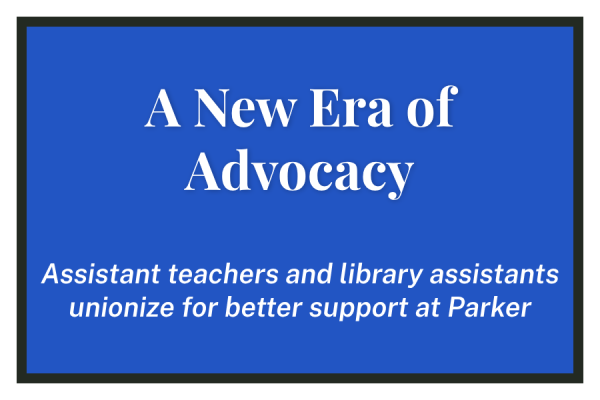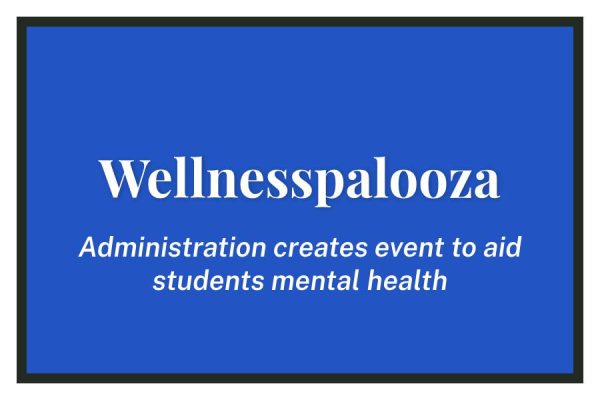The Cycle of Racism
Dr. Beverly Tatum Talks Race at Parker
Race–a social construction with no meaningful biological basis, created by human beings in order to categorize and marginalize. It’s a topic many people are too afraid to talk about, even though it impacts everyone whether they are conscious of its presence or not, silent or not.
Psychologist Dr. Beverly Tatum, author of “Why Are All the Black Kids Sitting Together in the Cafeteria?” among many other works on the psychology of racism, carried these ideas into the Parker auditorium on Tuesday in talks with both the entire Parker faculty, in the early afternoon, and the public in a Nightviews lecture later that night. A small number of faculty and students joined the evening audience of around 450 people. This is Tatum’s second visit to Parker. She last came in 2001.
“She’s iconic,” assistant Principal Ruth Jurgensen said. “She is so well known, and the fact that she’s spending time here is remarkable. She has always been a leader in education and one of those people you look up to from afar because she has accomplished so much in her career as an African American woman.”
Director of Diversity, Equity and Inclusion Dina Levi acknowledged that the timing of Tatum’s talk, both at Parker and in America, was significant. “Race is a hot button topic,” Levi said. “We are currently living out how hard it is to talk about race. We don’t always get it right, but we’re excited to do so. I hope that people will come away from this excited to talk and engage, and hopefully more willing and ready to do so.”
In the afternoon talk with the faculty, Tatum acknowledged that she had been prepped, prior to the talk, about the controversial October 26 “whiteness” Morning Ex at Parker.
“If you could do it over again, I would suggest a different sequence in the planning,” Tatum said in an interview. “This is clearly a community that is interested in dialogue. It seems to me it’s a community that has struggled to try to find the right format for those conversation, but wants to move the conversation forward.”
Tatum’s evening speech focused on how to talk about race, why it’s hard, and how to make a difference in it.
She began her discussion by asking the audience to share their first experience of race and their emotions in that experience. Most respondents randomly shouted that they were around three to five years old and that they felt confusion, shame, anger, and frustration–but held back from sharing their experience with anyone at the time.
“You see, we learn from such an early age not to talk about race,” Tatum said, “and there are many negative emotions associated with it.” Though many people think we are living in a post racial society, she said, we aren’t.
She featured a slide about “The Cycle of Racism,” a chart she believes represents how race gets entrenched, affecting everyone in America, giving systematic advantages to some, mostly white people, and systematic disadvantages to others, mostly people of color.
The cycle of racism, she said, starts as people are born into a society that largely avoids and fears the topic of race, leading to miscommunication, stereotypes, and prejudices that are reinforced through what is implied or not said by loved ones, institutions, and cultures.
This ultimately results in internalization, anger, confusion, and alienation. The only way to break out of this cycle, Tatum said, is to become aware of it and to intentionally start conversations and ask questions about it. She calls this “dissonance.”
“I believe that whenever I come visit schools, it’s a great opportunity,” Tatum said. “Humans naturally teach what they are taught, so if we are able to intentionally interrupt the cycle in an educational context, it’s very good, it’s progress. There are so many different kinds of ways to educate children of all ages.”
As the discussion ended, and questions opened up, 15 people came up to the two microphones to ask questions. One male educator told Tatum about a situation at the Chicago Public School at which he works, where the children of former Police Superintendent Gary McCarthy attend. Not long ago, most of the white faculty started wearing shirts in support of the Chicago police department, he said, which put the small number of black students and faculty in an uncomfortable position.
Tatum responded to the educator, explaining that he should start having discussions with the white faculty about the impact of their actions on the school’s community.
Over the summer, faculty members read Tatum’s 1997 (and subsequently updated) book “Why Are All the Black Kids Sitting Together in the Cafeteria?” Her book deals with how we see racism happening but don’t know how to hold discussions about it, and it does just that–it gets the race conversation going. This year, there have been a number of facilitated faculty discussions centered on race using the book as a common text guide.
“The faculty has been working to put together questions about things that came up from reading the book, things that come to their mind, and things they’re wondering because of the curriculum and practice,” Levi said. “It’s a great experience and resource to have Tatum come and engage with faculty, staff, and also students.”
On Wednesday, the day after the talks, Tatum was scheduled to speak to more faculty members and visit classrooms to talk with students on a more personal level, according to Jurgensen.
During Tatum’s afternoon discussion with the faculty, around ten teachers asked her questions about dealing with issues of race at Parker. The questions dealt with how to avoid students of color being victimized and hurt in racial discussions, how to get students to imagine characters in books who aren’t racially like them, how to move from talking about race and promoting diversity to taking action, and how students of color should be separated across classes in each grade.
In her answers to the questions, Tatum repeatedly brought up how race conversations have to include all the people within the conversation. Affinity groups, composed of like individuals who might be at risk of exclusion in these conversations, she said, can help connect people in supportive ways and help affirm identities.
“A lot of the times, you don’t notice race, and when you do, it makes you uncomfortable,” Tatum said during the faculty meeting. “There needs to be a plan for ongoing conversation. We have to push through the uncomfortableness in order to make progress. Conversation is like ear medicine. You take all of it–you have to continue, and if you stop, it makes it worse.”









